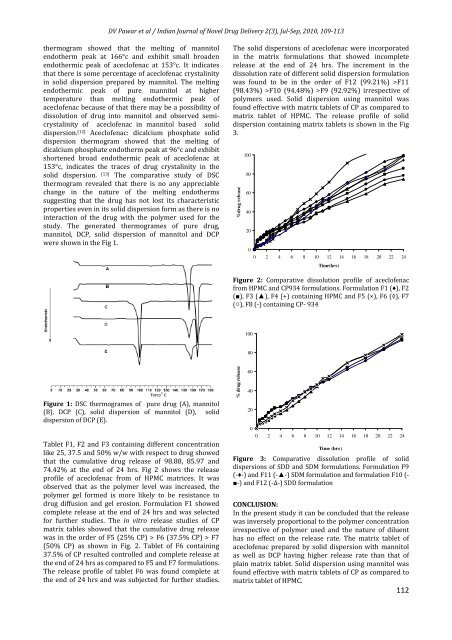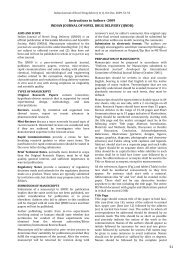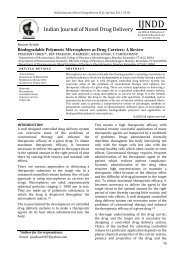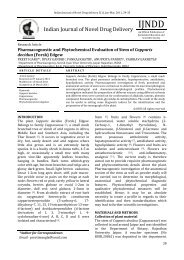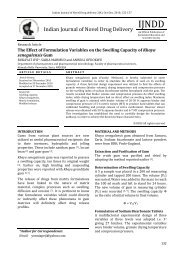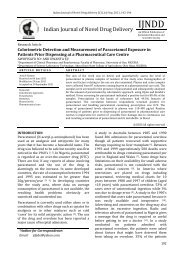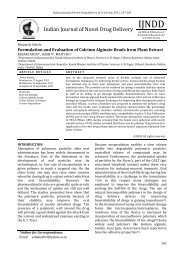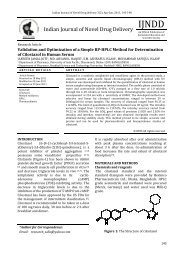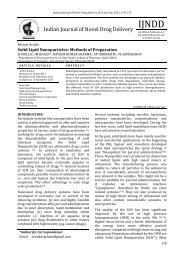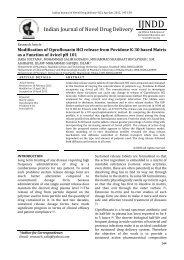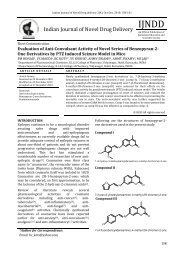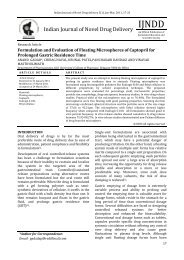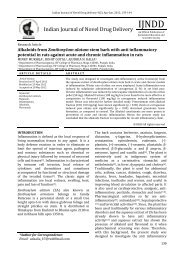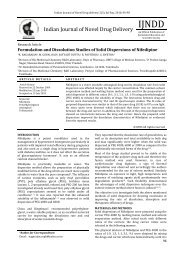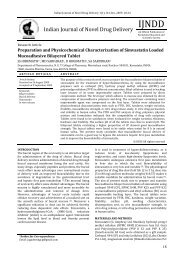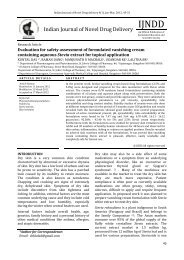Formulation and Evaluation of Controlled Release Matrix Tablet with ...
Formulation and Evaluation of Controlled Release Matrix Tablet with ...
Formulation and Evaluation of Controlled Release Matrix Tablet with ...
You also want an ePaper? Increase the reach of your titles
YUMPU automatically turns print PDFs into web optimized ePapers that Google loves.
DV Pawar et al / Indian Journal <strong>of</strong> Novel Drug Delivery 2(3), Jul-Sep, 2010, 109-113<br />
thermogram showed that the melting <strong>of</strong> mannitol<br />
endotherm peak at 166°c <strong>and</strong> exhibit small broaden<br />
endothermic peak <strong>of</strong> acecl<strong>of</strong>enac at 153°c. It indicates<br />
that there is some percentage <strong>of</strong> acecl<strong>of</strong>enac crystalinity<br />
in solid dispersion prepared by mannitol. The melting<br />
endothermic peak <strong>of</strong> pure mannitol at higher<br />
temperature than melting endothermic peak <strong>of</strong><br />
acecl<strong>of</strong>enac because <strong>of</strong> that there may be a possibility <strong>of</strong><br />
dissolution <strong>of</strong> drug into mannitol <strong>and</strong> observed semicrystalinity<br />
<strong>of</strong> acecl<strong>of</strong>enac in mannitol based solid<br />
dispersion. [12] Acecl<strong>of</strong>enac: dicalcium phosphate solid<br />
dispersion thermogram showed that the melting <strong>of</strong><br />
dicalcium phosphate endotherm peak at 96°c <strong>and</strong> exhibit<br />
shortened broad endothermic peak <strong>of</strong> acecl<strong>of</strong>enac at<br />
153°c, indicates the traces <strong>of</strong> drug crystalinity in the<br />
solid dispersion. [13] The comparative study <strong>of</strong> DSC<br />
thermogram revealed that there is no any appreciable<br />
change in the nature <strong>of</strong> the melting endotherms<br />
suggesting that the drug has not lost its characteristic<br />
properties even in its solid dispersion form as there is no<br />
interaction <strong>of</strong> the drug <strong>with</strong> the polymer used for the<br />
study. The generated thermogrames <strong>of</strong> pure drug,<br />
mannitol, DCP, solid dispersion <strong>of</strong> mannitol <strong>and</strong> DCP<br />
were shown in the Fig 1.<br />
The solid dispersions <strong>of</strong> acecl<strong>of</strong>enac were incorporated<br />
in the matrix formulations that showed incomplete<br />
release at the end <strong>of</strong> 24 hrs. The increment in the<br />
dissolution rate <strong>of</strong> different solid dispersion formulation<br />
was found to be in the order <strong>of</strong> F12 (99.21%) >F11<br />
(98.43%) >F10 (94.48%) >F9 (92.92%) irrespective <strong>of</strong><br />
polymers used. Solid dispersion using mannitol was<br />
found effective <strong>with</strong> matrix tablets <strong>of</strong> CP as compared to<br />
matrix tablet <strong>of</strong> HPMC. The release pr<strong>of</strong>ile <strong>of</strong> solid<br />
dispersion containing matrix tablets is shown in the Fig<br />
3.<br />
%drug release<br />
100<br />
80<br />
60<br />
40<br />
20<br />
0<br />
0 2 4 6 8 10 12 14 16 18 20 22 24<br />
Time(hrs)<br />
Figure 2: Comparative dissolution pr<strong>of</strong>ile <strong>of</strong> acecl<strong>of</strong>enac<br />
from HPMC <strong>and</strong> CP934 formulations. <strong>Formulation</strong> F1 (♦), F2<br />
(■), F3 (▲), F4 (+) containing HPMC <strong>and</strong> F5 (×), F6 (◊), F7<br />
(○), F8 (-) containing CP- 934<br />
100<br />
80<br />
Figure 1: DSC thermogrames <strong>of</strong> pure drug (A), mannitol<br />
(B), DCP (C), solid dispersion <strong>of</strong> mannitol (D), solid<br />
dispersion <strong>of</strong> DCP (E).<br />
<strong>Tablet</strong> F1, F2 <strong>and</strong> F3 containing different concentration<br />
like 25, 37.5 <strong>and</strong> 50% w/w <strong>with</strong> respect to drug showed<br />
that the cumulative drug release <strong>of</strong> 98.88, 85.97 <strong>and</strong><br />
74.42% at the end <strong>of</strong> 24 hrs. Fig 2 shows the release<br />
pr<strong>of</strong>ile <strong>of</strong> acecl<strong>of</strong>enac from <strong>of</strong> HPMC matrices. It was<br />
observed that as the polymer level was increased, the<br />
polymer gel formed is more likely to be resistance to<br />
drug diffusion <strong>and</strong> gel erosion. <strong>Formulation</strong> F1 showed<br />
complete release at the end <strong>of</strong> 24 hrs <strong>and</strong> was selected<br />
for further studies. The in vitro release studies <strong>of</strong> CP<br />
matrix tables showed that the cumulative drug release<br />
was in the order <strong>of</strong> F5 (25% CP) > F6 (37.5% CP) > F7<br />
(50% CP) as shown in Fig. 2. <strong>Tablet</strong> <strong>of</strong> F6 containing<br />
37.5% <strong>of</strong> CP resulted controlled <strong>and</strong> complete release at<br />
the end <strong>of</strong> 24 hrs as compared to F5 <strong>and</strong> F7 formulations.<br />
The release pr<strong>of</strong>ile <strong>of</strong> tablet F6 was found complete at<br />
the end <strong>of</strong> 24 hrs <strong>and</strong> was subjected for further studies.<br />
% drug release<br />
60<br />
40<br />
20<br />
0<br />
0 2 4 6 8 10 12 14 16 18 20 22 24<br />
Time (hrs)<br />
Figure 3: Comparative dissolution pr<strong>of</strong>ile <strong>of</strong> solid<br />
dispersions <strong>of</strong> SDD <strong>and</strong> SDM formulations. <strong>Formulation</strong> F9<br />
(-♦-) <strong>and</strong> F11 (-▲-) SDM formulation <strong>and</strong> formulation F10 (-<br />
■-) <strong>and</strong> F12 (-∆-) SDD formulation<br />
CONCLUSION:<br />
In the present study it can be concluded that the release<br />
was inversely proportional to the polymer concentration<br />
irrespective <strong>of</strong> polymer used <strong>and</strong> the nature <strong>of</strong> diluent<br />
has no effect on the release rate. The matrix tablet <strong>of</strong><br />
acecl<strong>of</strong>enac prepared by solid dispersion <strong>with</strong> mannitol<br />
as well as DCP having higher release rate than that <strong>of</strong><br />
plain matrix tablet. Solid dispersion using mannitol was<br />
found effective <strong>with</strong> matrix tablets <strong>of</strong> CP as compared to<br />
matrix tablet <strong>of</strong> HPMC.<br />
112


